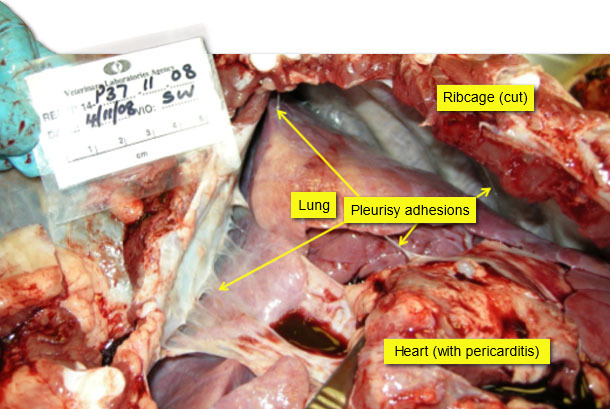What is pleurisy and how prevalent is it?
Pleurisy and pleuritis are synonymous terms to describe inflammation of the continuous membrane covering the outer surface of the lungs and inner surface of the thoracic wall and diaphragm. This inflammation resolves to leave fibrous collagen adhesions between the lung lobes and the thoracic wall; this often requires localised trimming during carcase processing. What is the prevalence of pleurisy? What is the economic impact and what advice for management can be taken from the known risk factors?


Figure 1.Typical lesions of chronic pleurisy. Note the adhesions between lungs and thoracic wall, and the presence of underlying pneumonia.
The prevalence of pleurisy is surprisingly high among pigs at slaughter. A recent review of available data ranged from 12.5% in the UK, 26% in Spain, to 41% of individual pigs slaughtered in one Norwegian study. Surprisingly, there was evidence of some pleurisy in 80% of all batches slaughtered in the UK between 2005 and 2008.
Table 1. Recent data on prevalence of pleurisy in slaughter pigs.
| Country | Year | Prevalence |
| Belgium | 2009 | 21 % |
| Denmark | 2000 | 25 % |
| Netherlands | 2004 | 22 % |
| Norway | 1991 | 41 % |
| Spain | 2009 | 26 % |
| UK | 2012 | 12 % |
Pleurisy is costly for producers and processors alike
The economic impacts of pleurisy have been studied both for producers and, to a lesser extent, for processors. One producer study considered group level effects across a total of 96,000 slaughter pigs divided into 80 slaughter batches, in turn representing all the major management systems in the UK. For each 1% increase in group level pleurisy prevalence at slaughter there was a concomitant 70g reduction in the mean post-trimming carcase weight for that group. Average daily liveweight gain could not be calculated due to the large size of the study and the different management systems included, so this figure is a composite of reduced growth and losses due to trimming after slaughter. Furthermore, the study found that for each 1% increase in group level pleurisy prevalence there was a 0.26 day increase in the group’s mean age at slaughter. This equates to an approximate national cost of £30m per year in the UK, using recent prices for pig meat, feed, an individual pig prevalence of 12% and a slaughter rate of 9m pigs per year. Less is known about the economic impact of pleurisy during processing but one limited assessment found that a typical slaughter batch with 10% prevalence of pleurisy required an approximate 8.5% reduction in line-speed and an additional slaughter operative, to allow for trimming, resulting in a mean additional cost of approximately £0.29 for every pig in the group. The welfare impacts of pleurisy are much more difficult to characterise but the high prevalence of this condition indicates the presence of widespread endemic respiratory disease despite modern intensive production techniques.
Farm level surveillance of pleurisy at slaughter is the first step in control
Surveillance of pleurisy prevalence at slaughter is prerequisite to implementation of a control program – both to determine economic impacts and thereby justify the expense of intervention, but also to evaluate the response to interventions over time. Quarterly recording of pleurisy prevalence and other gross pathology visible at slaughter should be done using a statistically representative sample size (e.g. 50 pigs per batch).
Control pleurisy using basic principles and known risk factors
Planning a pleurisy control program that has local relevance requires a back-to-basics approach to disease control principles and some awareness of recent work on related risk factors. In general, the balance between health and disease always depends on three sets of factors. Pig susceptibility (i.e. immunity), pathogen challenge, and environmental factors supporting transmission. Pig immunity is usually managed by vaccination against critical respiratory pathogens (see later) but it is also affected, at least in the first 8 -10 weeks of life, by passive antibody derived from colostrum. This quality of this colostrum-derived immune protection is affected, in turn, by management factors including sow nutrition, parity structure, and farrowing room management. Other important factors that impact on susceptibility or immunity include breed genetics (there is some evidence of relative respiratory robustness of the Hampshire breed), and also the immune dysregulatory pathogens porcine reproductive and respiratory syndrome virus (PRRSV), porcine circovirus type 2 (PCV2), and Mycoplasma hyopneumoniae (M. hyo). These pathogens act not only to cause respiratory disease directly, but also to disable innate and acquired immunity pathways that act against other respiratory pathogens.
A number of studies have together identified a range of pathogens important in driving pleurisy and respiratory disease – usually acting in a polymicrobial manner to drive what is now termed as porcine respiratory disease complex (PRDC). In addition to PRRSV, PCV2, and M. hyopneumoniae, other pathogens important for PRDC and pleurisy include the bacteria Actinobacillus pleuropneumoniae, Pasteurella multocida, and to alesser degree Haemophilus parasuis and Streptococcus suis. Other important viruses include influenza viruses, porcine respiratory coronavirus, and Aujeszky’s disease virus. From this information, a vaccine control program should be designed that is based on diagnostic evidence for the herd in question. The most relevant diagnostic information will be obtained from herd level serological testing combined with representative necropsy investigation and microbiological sampling from 3-6 of the youngest pigs showing respiratory signs on the farm.
Environmental factors are extremely important in driving pleurisy, as shown by a number of recent studies that all confirm the value of aiming for the goal of all-in all-out production from weaning to slaughter (reviewed by Jager et al 2012). Strict AIAO may not be feasible on many smaller or older farms but there is evidence that implementing management elements that contribute to AIAO may help to reduce the likelihood of severe pleurisy. For example, restricting age range to <1 month in the same airspace, and cleaning, disinfection and resting of pens between batches of pigs.






